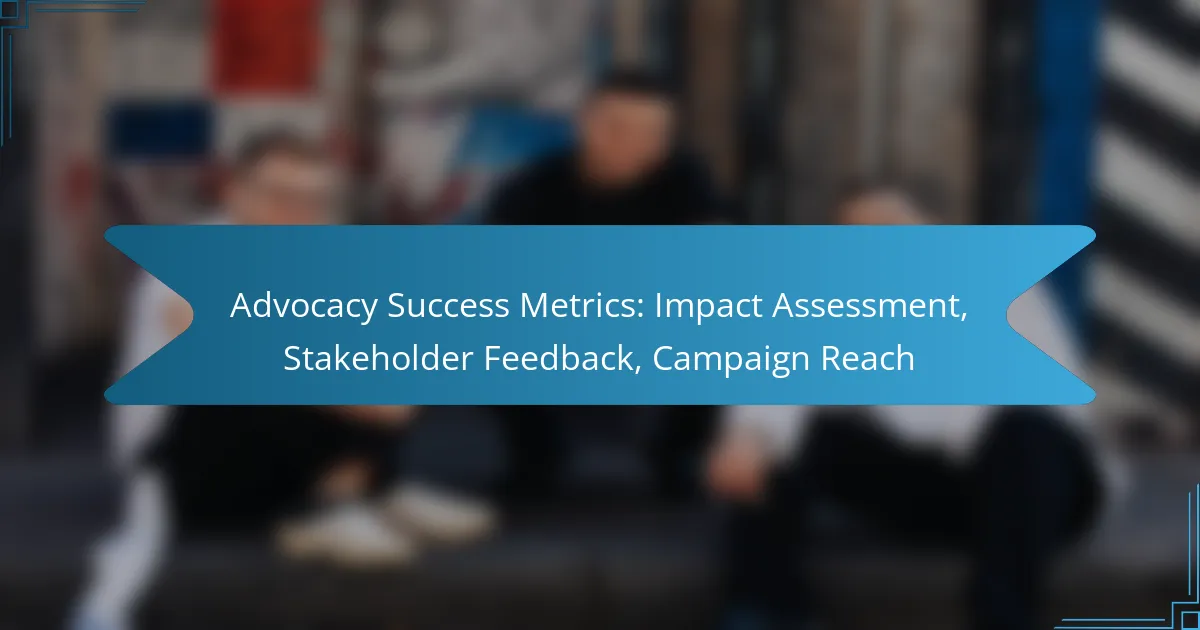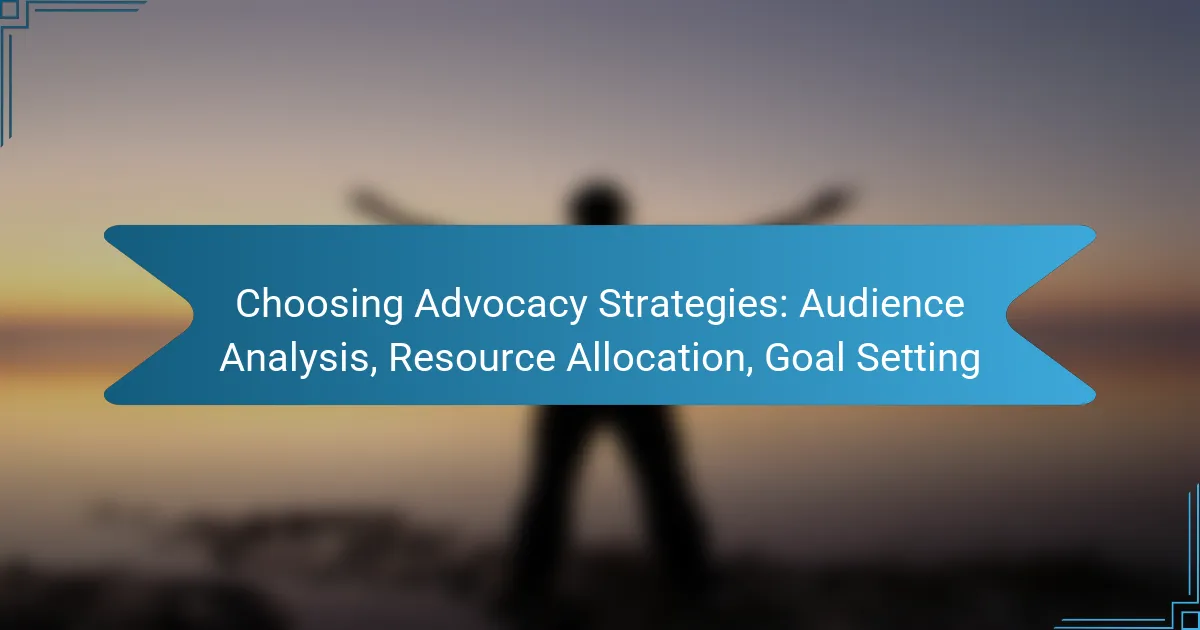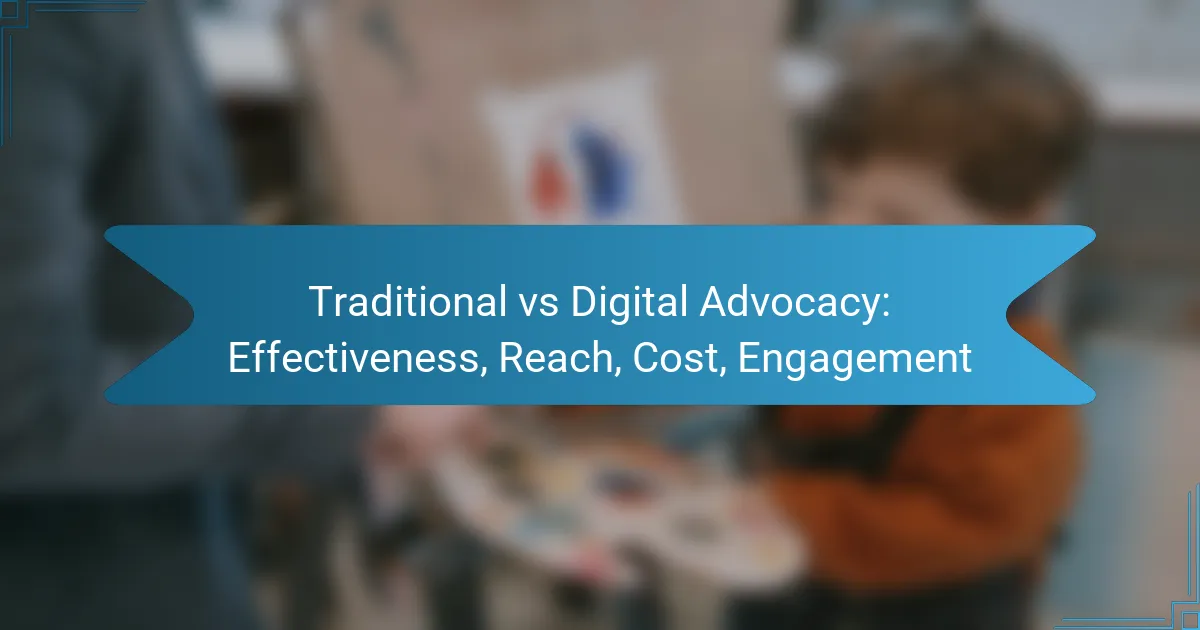Advocacy success metrics are essential for organizations aiming to evaluate the effectiveness of their campaigns. Key components such as impact assessment, stakeholder feedback, and campaign reach provide valuable insights that inform strategy adjustments. By utilizing both quantitative and qualitative measures, organizations can gain a comprehensive understanding of their advocacy efforts and enhance future initiatives.
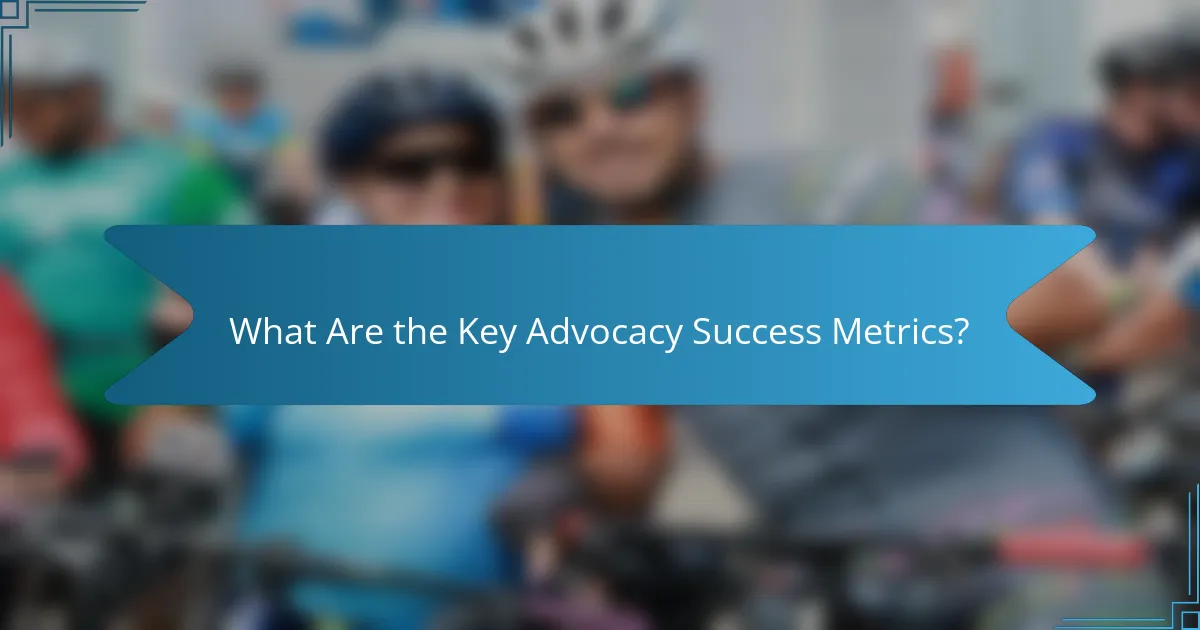
What Are the Key Advocacy Success Metrics?
Key advocacy success metrics include impact assessment, stakeholder feedback, and campaign reach. These metrics help organizations evaluate the effectiveness of their advocacy efforts and adjust strategies accordingly.
Impact Assessment
Impact assessment measures the tangible effects of advocacy initiatives on target populations or issues. This can include changes in policy, funding allocations, or public awareness levels. To effectively assess impact, consider using both qualitative and quantitative data, such as surveys, case studies, and statistical analysis.
Common methods for impact assessment include pre- and post-campaign evaluations, which can help identify shifts in public opinion or policy outcomes. Establish clear objectives at the outset to facilitate measurement and ensure alignment with overall advocacy goals.
Stakeholder Feedback
Stakeholder feedback provides insights from individuals or groups affected by advocacy efforts. This feedback can be gathered through interviews, focus groups, or surveys, and is crucial for understanding perceptions and experiences related to the campaign. Engaging stakeholders throughout the process fosters trust and can enhance the effectiveness of advocacy strategies.
Consider implementing regular feedback loops to capture stakeholder insights at various stages of the campaign. This approach allows for timely adjustments and demonstrates responsiveness to community needs, ultimately strengthening relationships and support.
Campaign Reach
Campaign reach refers to the extent to which advocacy messages are disseminated and received by the target audience. This metric can be quantified through various channels, including social media impressions, email open rates, and attendance at events. Understanding reach helps organizations gauge the visibility and penetration of their advocacy efforts.
To maximize campaign reach, utilize a mix of communication channels tailored to the audience. Monitor engagement metrics to identify which platforms yield the best results and adjust strategies accordingly. Regularly assess reach to ensure that advocacy messages are effectively reaching and resonating with intended audiences.

How to Measure Impact in Advocacy Campaigns?
Measuring impact in advocacy campaigns involves evaluating both the outcomes achieved and the effectiveness of the strategies used. This assessment can be broken down into quantitative and qualitative metrics, each providing valuable insights into the campaign’s success.
Quantitative Metrics
Quantitative metrics focus on numerical data that can be easily measured and analyzed. Common examples include the number of petitions signed, social media shares, or attendance at events. These figures provide clear evidence of engagement and reach, helping to gauge the overall impact of the campaign.
To effectively use quantitative metrics, establish baseline figures before launching the campaign. This allows for comparison and helps in understanding growth or decline. Aim for specific targets, such as increasing petition signatures by 20% or doubling social media engagement within a set timeframe.
Qualitative Metrics
Qualitative metrics assess the subjective aspects of advocacy campaigns, such as stakeholder feedback and personal testimonials. These insights can reveal the emotional and social impact of the campaign, providing context that numbers alone cannot convey. Gathering stories from beneficiaries or partners can illustrate the campaign’s significance and effectiveness.
To collect qualitative data, consider conducting interviews or focus groups with key stakeholders. This approach can uncover deeper insights into perceptions and attitudes. Additionally, analyze social media comments or feedback forms to identify themes and sentiments that reflect the campaign’s impact on the community.

What Tools Are Available for Measuring Advocacy Success?
Measuring advocacy success involves various tools that provide insights into impact assessment, stakeholder feedback, and campaign reach. These tools help organizations evaluate their effectiveness and refine strategies for future initiatives.
Google Analytics
Google Analytics is a powerful tool for tracking website traffic and user behavior, making it essential for measuring advocacy campaign reach. By analyzing metrics such as page views, session duration, and user demographics, organizations can assess how well their campaigns are engaging audiences.
To effectively use Google Analytics, set up specific goals related to your advocacy efforts, such as newsletter sign-ups or petition completions. Regularly review reports to identify trends and adjust your strategies accordingly.
Hootsuite
Hootsuite is a social media management platform that allows users to monitor and analyze their social media campaigns. It provides insights into engagement metrics such as likes, shares, and comments, which are crucial for understanding stakeholder feedback.
Utilize Hootsuite’s analytics features to track the performance of individual posts and campaigns over time. This can help you identify which messages resonate most with your audience and inform future content strategies.
SurveyMonkey
SurveyMonkey is an online survey tool that enables organizations to gather direct feedback from stakeholders. This tool is particularly useful for assessing the impact of advocacy efforts through tailored questionnaires.
Create surveys that focus on specific aspects of your campaign, such as awareness, perception, and suggestions for improvement. Analyze the results to gain actionable insights that can enhance your advocacy strategies and better meet stakeholder needs.

How to Gather Stakeholder Feedback Effectively?
Gathering stakeholder feedback effectively involves using structured methods to collect insights that inform decision-making. By employing various techniques, organizations can ensure they capture diverse perspectives and actionable data.
Surveys and Questionnaires
Surveys and questionnaires are popular tools for collecting stakeholder feedback due to their scalability and efficiency. They can be distributed online or in person, allowing for a broad reach, and can include multiple-choice, rating scales, or open-ended questions to gather quantitative and qualitative data.
When designing surveys, keep questions clear and concise to avoid confusion. Aim for a completion time of under 10 minutes to maximize response rates. Consider using platforms like SurveyMonkey or Google Forms for easy distribution and analysis.
Focus Groups
Focus groups involve guided discussions with a small group of stakeholders, typically ranging from 6 to 12 participants. This method allows for in-depth exploration of opinions and attitudes, providing richer qualitative insights than surveys alone.
To conduct effective focus groups, select a diverse group of participants that represent different stakeholder segments. Prepare open-ended questions to facilitate discussion and ensure a skilled moderator is present to guide the conversation and keep it on track.
Interviews
Interviews offer a personalized approach to gathering stakeholder feedback, allowing for detailed conversations that can uncover nuanced insights. They can be structured, semi-structured, or unstructured, depending on the depth of information needed.
When conducting interviews, consider scheduling sessions that last between 30 to 60 minutes. Prepare a set of core questions but remain flexible to explore emerging topics. Ensure confidentiality to encourage honest feedback, and follow up with a summary of key points discussed to validate stakeholder contributions.

What Is the Importance of Campaign Reach?
Campaign reach is crucial as it measures the total number of individuals exposed to a campaign, indicating its potential impact. A broader reach can enhance engagement and drive more significant outcomes for advocacy efforts.
Audience Engagement
Audience engagement refers to how actively the target audience interacts with a campaign. High engagement levels often translate to increased support and participation, which can be achieved through compelling content and strategic outreach.
To enhance audience engagement, consider using interactive elements such as polls, quizzes, or social media challenges. These tactics can foster a sense of community and encourage more profound connections with your cause.
Brand Awareness
Brand awareness is the extent to which people recognize and remember a brand or campaign. A successful campaign reach contributes to higher brand awareness, which can lead to increased trust and credibility among stakeholders.
To build brand awareness, utilize consistent messaging across various platforms, including social media, email newsletters, and community events. Aim for a multi-channel approach to ensure your message resonates with diverse audiences.

How to Analyze Stakeholder Feedback?
Analyzing stakeholder feedback involves systematically collecting and interpreting opinions to gauge the effectiveness of advocacy efforts. This process helps organizations understand stakeholder perceptions, identify areas for improvement, and refine strategies for future campaigns.
Thematic Analysis
Thematic analysis is a qualitative method that involves identifying and analyzing patterns or themes within stakeholder feedback. This approach allows organizations to categorize responses based on common topics, providing insights into stakeholder priorities and concerns.
To conduct a thematic analysis, start by coding the feedback into key themes. For example, if multiple stakeholders mention “communication” as a concern, this theme can be highlighted for further exploration. It is essential to ensure that the themes accurately represent the feedback and are not influenced by bias.
Sentiment Analysis
Sentiment analysis uses natural language processing to evaluate the emotional tone of stakeholder feedback. This method helps organizations understand whether the feedback is positive, negative, or neutral, which can inform decision-making and strategy adjustments.
When implementing sentiment analysis, consider using software tools that can process large volumes of text efficiently. For instance, a tool might categorize feedback into positive, negative, and neutral sentiments, allowing for quick assessments of overall stakeholder satisfaction. However, be cautious of nuances in language that automated tools may misinterpret, so it’s beneficial to complement this analysis with human review.
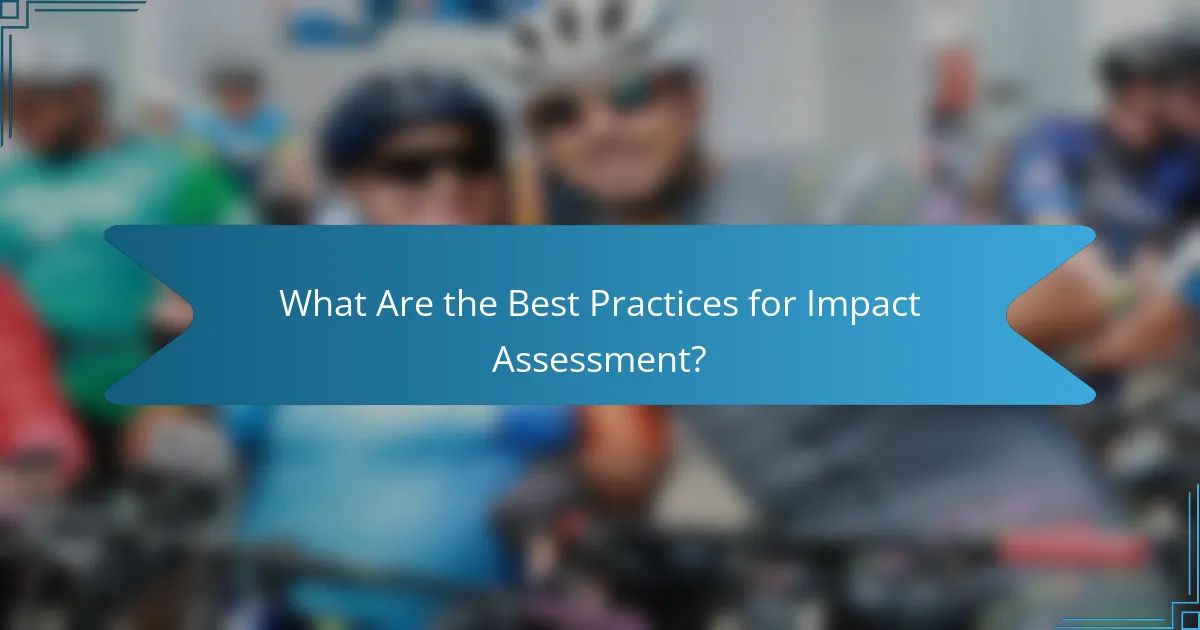
What Are the Best Practices for Impact Assessment?
Best practices for impact assessment involve setting clear objectives, utilizing appropriate metrics, and engaging stakeholders effectively. These practices ensure that advocacy efforts are measured accurately and improvements can be made based on feedback and data.
Setting Clear Objectives
Setting clear objectives is crucial for effective impact assessment. Objectives should be specific, measurable, achievable, relevant, and time-bound (SMART). This clarity helps in determining the success of advocacy campaigns and in aligning stakeholders’ expectations.
When defining objectives, consider both short-term and long-term goals. For instance, a short-term objective might be to increase community awareness of a specific issue by 30% within six months, while a long-term goal could aim for policy changes within two years.
To avoid common pitfalls, ensure that objectives are realistic and based on available resources. Regularly review and adjust these objectives as necessary to reflect changing circumstances or insights gained from ongoing assessments.
